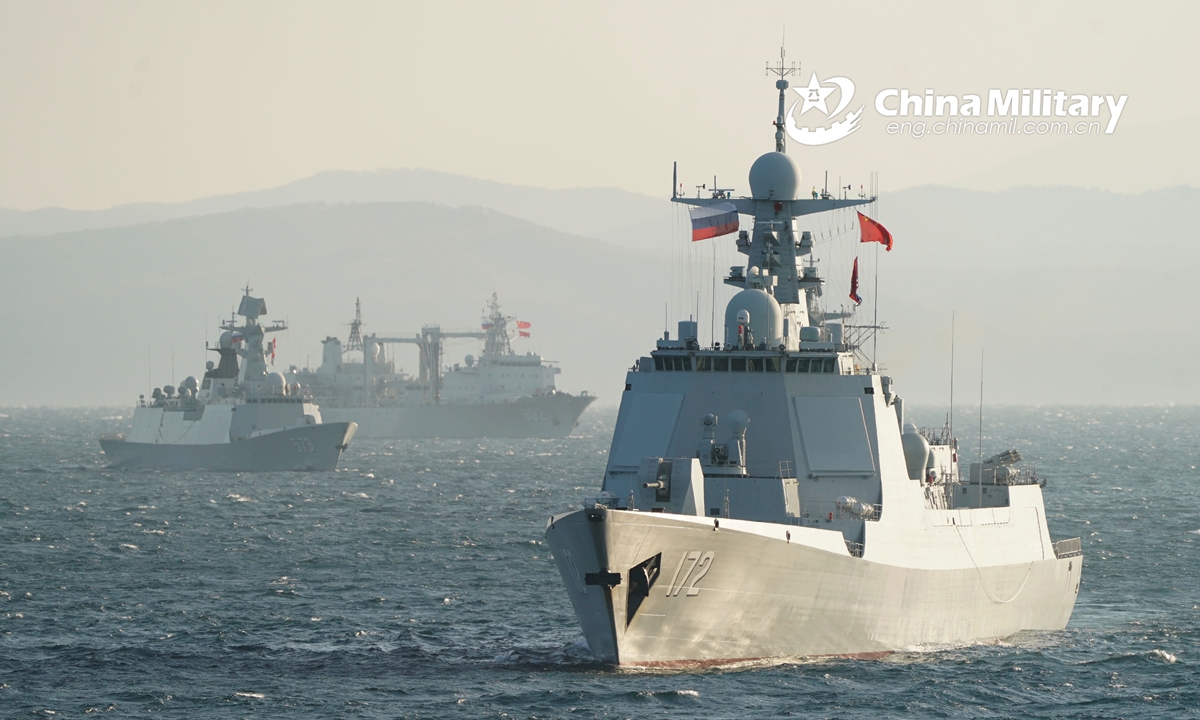
In first joint-patrol, Chinese and Russian warships sail
through Tsugaru Strait in line with international law.
Guo Yuandan and Liu Xuanzun / Global Times
Chinese and Russian warships transit simulated mined sea area during the naval exercise Joint Sea-2021 on the morning of October 15. The China-Russia joint naval exercise kicked off in waters near Russia’s Peter the Great Bay on the afternoon of October 14, which focused on such training subjects as communications, mine countermeasures, air defense, live-fire shooting at maritime targets, joint maneuvering and joint anti-submarine missions.Photo:Xinhua
(October 19, 2021) — Right after China and Russia wrapped up a joint naval exercise in the Sea of Japan on Sunday, 10 powerful warships from the two countries switched to the next mission and sailed through the Tsugaru Strait into the Pacific Ocean on Monday in their first joint maritime patrol, which experts said on Tuesday could see the joint task force encircle Japan or approach the US.
The joint patrol displays a high level of political and military mutual trust that exists between China and Russia in terms of safeguarding regional peace and stability, at a time when the US is ganging up with its allies like Japan and Australia and destabilizing Asia-Pacific.
The Japan Maritime Self-Defense Force spotted a joint flotilla consisting of 10 warships from China and Russia, namely the Type 055 guided missile destroyer Nanchang, the Type 052D guided missile destroyer Kunming, the Type 054A guided missile frigates Binzhou and Liuzhou and the Type 903A comprehensive supply ship Dongpinghu from China, and the large anti-submarine ships Admiral Panteleev and Admiral Tributs, the instrumentation ship Marshal Krylov, and the corvettes of the project 20380 Hero of the Russian Federation Aldar Tsydenzhapov and Gromkiy from Russia, when they passed through the Tsugaru Strait, between Japan’s main island of Honshu and Hokkaido, and sailed toward the Pacific Ocean on Monday, Japan’s Ministry of Defense Joint Staff said in a press release on the day.
This is the first time Chinese and Russian warships were seen transiting the Tsugaru Strait together, the Japanese press release said.
The Tsugaru Strait is no territorial water, and warships from any country have the right to transit, which means the transit of the Chinese and Russian vessels is completely in line with the international law and common practice, Zhang Junshe, a senior research fellow at the Naval Research Academy of the People’s Liberation Army (PLA), told the Global Times on Tuesday.
Many of the ships just completed the Joint Sea-2021 naval exercise in waters near Russia’s Peter the Great Gulf, which started on Thursday and concluded on Sunday. The ships practiced more than 20 joint tasks including mine defense, live-fire artillery shooting, air defense, maneuvering, communications and anti-submarine missions, according to a statement released by Russia’s Defense Ministry on Monday and official Chinese media reports over the past few days.
The two countries’ warships are apparently on their first strategic joint maritime patrol right after the joint drill, observers said.
During the Joint Sea-2013, Chinese warships entered the Sea of Japan for the drills via the Tsushima Strait, and after the drills, some participating vessels sailed through the Soya Strait into the Pacific Ocean, before returning to the East China Sea from the Miyako Strait. This was the first time PLA warships had encircled the Japanese archipelago.
It is possible that the Chinese and Russian warships could encircle Japan again, Song Zhongping, a Chinese military expert and TV commentator, told the Global Times on Tuesday.
They could turn south and return to the East China Sea from the Miyako Strait or Osumi Strait, which means an encirclement of Japan’s main island, or they could turn north and again enter the Sea of Japan from the Soya Strait, which means an encirclement of Japan’s Hokkaido, analysts said.
In August, a PLA flotilla led by the Nanchang destroyer reportedly sailed in international waters near the US, off the coast of the Aleutian Islands in Alaska.

In June, Russian warships, including the Hero of the Russian Federation Aldar Tsydenzhapov and Gromkiy corvettes, practiced destroying a “carrier strike group of a mock enemy” off the coast of Hawaii, US-based news website military.com reported at the time.
It is also possible that the PLA warships will again approach the US, said Shi Hong, executive chief editor of the Chinese magazine Shipborne Weapons.
As the PLA Navy expands its far sea training, there is no limitation to where it can go as long as the international law allows, Shi told the Global Times.
China and Russia held two strategic joint aerial patrols in 2019 and 2020 in the Sea of Japan and the East China Sea, with a third one expected in 2021, which could feature more types of aircraft and a larger fleet, observers said.
With the first strategic joint maritime patrol being held, such patrol could also become routine, and a joint aerial and maritime patrol could take place in the future, they said.
China and Russia have made many military interactions in 2021, including the Zapad/Interaction-2021 strategic exercise held in China in August.
At a time when the international situation is undergoing profound changes — as the US is ganging up with its allies like Japan and Australia and interfering in and destabilizing Asia-Pacific affairs — China and Russia must have countermeasures, enhance strategic cooperation and boost the width and depth of their military exercises, said a Chinese military expert who requested anonymity.
China and Russia displayed a stronger joint combat capability and a higher level of military cooperation, which is a warning to the US and its allies, Song said.
China and Russia are a key ballast stone to world peace and stability and maintaining the regional situation, and can deter Western countries led by the US, at a time when the US is rallying up its allies in an attempt to maintain hegemony, Song said.
Posted in accordance with Title 17, Section 107, US Code, for noncommercial, educational purposes.